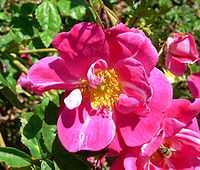William Baffin
| William Baffin | |
|---|---|
 William Baffin by Hendrick van der Borcht | |
| Born | London |
| Died |
23 January 1622 Qeshm, Ormus |
| Nationality | English |
| Occupation | Navigator, explorer |
William Baffin (died 23 January 1622) was an English navigator and explorer. Nothing is known of his early life, but it is conjectured that he was born in London of humble origin, and gradually raised himself by his diligence and perseverance. Britannica 11th Edition gives a year of birth as 1584, but this is simply a guess, without any documentary basis.[1]
Explorations
The earliest mention of William Baffin occurs in 1612, when he was chief pilot on an expedition to Greenland with Captain James Hall. Captain Hall had been on three previous voyages to Greenland for Denmark's King Christian IV's Expeditions to Greenland, after which King Christian gave up on his attempts to re-discover old Greenland. Hall, still keen for further exploration, obtained the backing for the 1612 voyage of discovery to Greenland from four English merchants: Sir Thomas Smythe, Sir James Lancaster, Sir William Cockayne, and Mr. Richard Ball. William Baffin and Captain Hall were on board the Patience and were accompanied by another vessel[2] Captain Hall was killed in a fight with local inhabitants on the west coast of Greenland.
During the following two years Baffin served in the Spitsbergen whale-fishery, at that time controlled by England's Muscovy Company. In the first year he served as pilot aboard the flagship of the whaling fleet, the Tiger, while in the second year he served as pilot aboard the Thomasine, one of the fleet's two discovery ships.
The Company of Merchants of London, Discoverers of the North-West Passage was formed in 1612, with Sir Thomas Smythe as its Governor and Sir James Lancaster, Sir Francis Jones, Sir Dudley Digges, and Sir John Wolstenholme among his prominent merchant colleagues.[3]
In 1615, Baffin entered the service of the Company for the discovery of the Northwest Passage, and accompanied Captain Robert Bylot as pilot of the little ship Discovery, and now carefully explored the Hudson Strait. The accuracy of Baffin's tidal and astronomical observations on this voyage was confirmed in a remarkable manner by Sir Edward Parry, when passing over the same ground, two centuries later (1821).
The following year, Baffin again sailed as pilot of the Discovery, sailing to the west of Greenland and north up through the Davis Strait, where he discovered the large bay to the north which now bears his name, together with the series of straits which radiate from its head and were named by him Lancaster, Smith and Jones Sounds, in honour of the patrons of his voyages. On this voyage he sailed over 300 statute miles (480 km) farther north than his predecessor John Davis. His Furthest North, about lat. 77° 45', remained unsurpassed in North America until 1852 when Edward Augustus Inglefield reached 78° 28' in the same area. All hopes of discovering a passage to India by this route seemed to be at an end and Baffin Bay was not explored again for two centuries. Parts of Baffin's journal were printed by Samuel Purchas in 1625 but, for economic reasons, the charts and hydorgraphic observations were not. The charts were soon lost. Eventually Baffin's discoveries came to be doubted. In 1818 John Ross re-explored Baffin Bay. "Baffin had long been one of Ross's heroes, and later he would write of the satisfaction he derived of proving wrong those who, for so long, had doubted Baffin's accomplishment."[4]
Baffin next took service with the English East India Company, and in 1617–1619 sailed to Surat in British India, and on his return received the special recognition of the Company for valuable surveys of the Red Sea and Persian Gulf which he had made in the course of the voyage.
Early in 1620, he again sailed to the East. In the Anglo-Persian attack on the Portuguese fort on Kishm island in the Persian Gulf, a preliminary to the Capture of Ormuz, he died from a gunshot wound to his stomach on 23 January 1622.
Legacy

Besides the importance of his geographical discoveries, Baffin is remembered for the accuracy of his numerous scientific and magnetic observations, including the determination of longitude at sea by lunar observation or Lunar Distance.
Baffin Bay and Baffin Island are named in his honour.[5] The William Baffin rose, developed by Agriculture and Agri-Food Canada, was named in his honour.[6]
See also
References
- ↑ "BAFFIN, WILLIAM". University of Toronto/Université Laval. Retrieved 24 September 2013.
- ↑ Markham, Clements R (1881). The Voyages of William Baffin, 1612–1622. The Hakluyt Society. pp. xx–xxi.
- ↑ Markham, Clements R (1881). The Voyages of William Baffin, 1612–1622. The Hakluyt Society. pp. v–vi,xxx.
- ↑ Sandler, Martin W. (2008). Resolute: The Epic Search for the Northwest Passage and John Franklin, and the Discovery of the Queen's Ghost Ship. Sterling Publishing Company, Inc. p. 27.
- ↑ Quinn, Joyce A.; Woodward, Susan L. (31 January 2015). Earth's Landscape: An Encyclopedia of the World's Geographic Features. ABC-CLIO. p. 82. ISBN 978-1-61069-446-9.
- ↑ William Baffin rose
| Wikisource has the text of the 1911 Encyclopædia Britannica article Baffin, William. |
- Biography at the Dictionary of Canadian Biography Online
- Markham, Clements R. (2001). The Voyages of William Baffin, 1612–1622 (2001 ed.). Adamant Media Corporation. p. 279. ISBN 1-4021-9532-X.
(Clements Markham's edit of journals of five voyages written by Baffin. Facsimile of original published 1881 by Hakluyt Society.)
External links
| Wikimedia Commons has media related to William Baffin. |
|